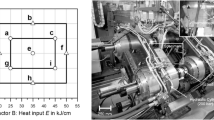Abstract
As a result of current trends towards lightweight design, a growing amount of high-strength steels with yield strengths above 690 MPa is applied. In comparison to the weld process of lower-strength steels, small working ranges have to be achieved with respect to a special microstructure and high yield ratio. However, the sustainable and economic application of these steels depends on the loading capacity and the safety of welds when designing weld constructions. For these demands, a precise knowledge of welding stress level and distribution is essential. Therefore, the present study is concerned with the interaction between heat control (interpass temperature and heat input) and local as well as global stresses in high-strength steel welds. Specimens were multirun welded under defined restraint conditions in a special test facility (controlled tensile weldability (CTW) test) to consider global restraint. For the comparison concerning local residual stresses, free shrinkage test welds were performed as well. The evaluation shows a significant influence of the interpass temperature on the global reaction forces. Furthermore, increased heat input and high interpass temperatures cause higher tensile residual stresses. This occurred in the weld area of both free shrinkage test specimen and CTW test specimen.












Similar content being viewed by others
References
Horikawa K, Watanabe N (2009) Application of extra-high tensile strength steel for hydropower plants in Japan. In: Conference on high strength steels for hydropower plants—Takasaki, Japan, pp. 1–8
Klein M, Spindler H, Luger A, Rauch R, Stiaszny P, Eigelsberger M (2005) Thermomechanically hot rolled high and ultra high strength steel grades—processing, properties and application. Mater Sci Forum 500–501:543–550, http://www.scientific.net/MSF.500-501.543
Hulka K, Kern A, Schriever U (2005) Application of niobium in quenched and tempered high-strength steels. Mater Sci Forum 500–501:519–526, http://www.scientific.net/MSF.500-501.519
Hanus F, Schroeter F, Schuetz W (2005) State of art in the production and use of high-strength heavy plates for hydropower applications. In: High strength steel for hydropower plants, pp. 1–13, Graz
Grong O (1997) Metallurgical modelling of welding. Institute of Materials ISBN: 9781861250360
EN 1011-2: Welding—recommendation for welding of metallic materials—part 2: arc welding of ferritic steels. 2001
Wongpanya P, Boellinghaus T, Lothongkum G (2008) Ways to reduce the cold cracking risk in high strength structural steel welds. International Conference of the International Institute of Welding, Johannesburg, South Africa
Uwer D, Hohne H (1992) Determination of suitable minimum preheating temperatures for the cold-crack-free welding of steels. Weld Res Abroad 38(5):31–35, ISSN: 0043–2318
Masubuchi K (1980) Analysis of welded structures: residual stresses, distortion, and their consequences. Pergamon Press, New York. ISBN 9780080261294
Schwenk C, Kannengiesser T, Rethmeier M (2009) Restraint conditions and welding residual stresses in self-restrained cold cracking tests. In: Materials research, pp. 766-773
Rhode M, Kromm A, Kannengiesser T (2013) Residual stresses in multi-layer component welds. In: Trends in welding research: proceedings of the 9th international conference, June 4–8, 2012 Chicago, Illinois, USA, pp. 48–54, ASM International, ISBN: 1-62708-998-8
Boellinghaus T, Kannengiesser T, Neuhaus M (2005) Effects of the structural restraint intensity on the stress strain build up in butt joints. Math Modell Weld Phenom 7:651–669, 3-901351-99-X
Wongpanya P, Boellinghaus T, Lothongkum G (2008) Heat treatment procedures for hydrogen assisted cold cracking avoidance in s 1100 ql steel root welds. In: Materials research, no. d
Kannengiesser T, Lausch T, Kromm A (2011) Effects of heat control on the stress build-up during high-strength steel welding under defined restraint conditions. In: Welding in the world, vol. 55, no. 07, pp. 58–65, Springer, ISSN: 0043-2288
Eurocode 3 (2010): Design of steel structures (EN 1993)
EN 10025-6: Hot rolled products of structural steels—part 6: technical delivery conditions for flat products of high yield strength structural steels in the quenched and tempered condition. 2009
ISO 16834: Welding consumables—wire electrodes, wires, rods and deposits for gas shielded arc welding of high strength steels—classification. 2012
ISO 15614-1 (2012) Specification and qualification of welding procedures for metallic materials—welding procedure test—part 1: arc and gas welding of steels and arc welding of nickel and nickel alloys
Satoh K, Ueda Y, Matsui S, Natsume M, Terasaki T, Fukuda K, Tsuji M (1977) Japanese studies on structural restraint severity in relation to weld cracking. In: Welding in the world, vol. 15, no. 7, pp. 155–189, Springer, ISSN: 0043-2288
Nitschke-Pagel T, Wohlfahrt H (2002) Residual stresses in welded joints—sources and consequences. Mater Sci Forum 404–407:215–226. doi:10.4028/www.scientific.net/MSF.404-407.215
Nitschke-Pagel T, Wohlfahrt H (1991) The generation of residual stresses due to joining processes. In: Residual stresses—measurement, calculation, evaluation. V. Hauk, H. Hougardy, E. Macherauch (Ed.), pp. 121–133, DGM Informationsgesellschaft mbH, ISBN: 3-88355-169-4
ISO 14175: Welding consumables—gases and gas mixtures for fusion welding and allied processes. 2008
Lausch T, Kannengiesser T, Schmitz-Niederau M (2013) Multi-axial load analysis of thick-walled component welds made of 13CrMoV9-10. J Mater Process Technol 213:1234–1240. doi:10.1016/j.jmatprotec.2013.01.008
Acknowledgments
The studies were funded by the AIF-project IGF-No. 17267 N/FOSTA P922. Sincere thanks are given for this support and to the representing companies actively involved in the project board.
Author information
Authors and Affiliations
Corresponding author
Additional information
Doc. IIW-2442, recommended for publication by Commission II “Arc Welding and Filler Metals”
Rights and permissions
About this article
Cite this article
Schroepfer, D., Kannengiesser, T. Correlating welding reaction stresses and weld process conditions for high-strength steel S960QL. Weld World 58, 423–432 (2014). https://doi.org/10.1007/s40194-014-0127-x
Received:
Accepted:
Published:
Issue Date:
DOI: https://doi.org/10.1007/s40194-014-0127-x




